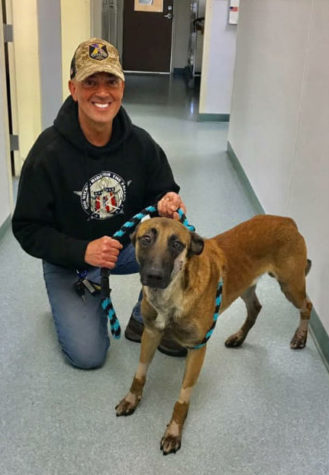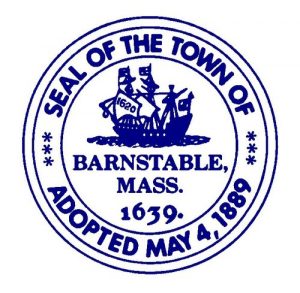
State Representative Stephen Xiarhos with K9 Nero. Xiarhos was the Yarmouth Police Deputy Chief when Nero was shot.
YARMOUTH – State Representative Steven Xiarhos reports that Massachusetts Governor Charlie Baker has signed Nero’s Law into effect. The act allows EMTs to treat and transport police dogs who are shot in the line of duty. Efforts to enact the law came out in the wake of K9 Nero of the Yarmouth Police Department being shot and seriously injured in an incident in Marstons in 2018 where his handler Yarmouth Police Sgt. Sean Gannon was fatally shot. Regulations at the time prohibited EMTs from treating or transporting Nero to a veterinary hospital. Nero was rushed by police cruiser and did survive a long road to recovery. Nero was retired and lives with Gannon’s widow Dara. The suspect in the shooting was sentenced to 25 years to life for the shooting.
Statement from Yarmouth Police:
“Nero’s Law Signed By Governor Baker”
Thanks to Dr. Kevin Smith, former Representative Will Crocker and Representative Steven Xiarhos for being the driving force to passing “Nero’s Law” that allows immediate care for Police K9’s who are injured.
We learned on April 12th, 2018 when our beloved Sgt. Sean Gannon was killed that his K9 Nero was also seriously injured by a gun shot. Paramedics and and ambulance crews were not allowed by law to treat or transport a K9. With the support of the Gannon family, Dr. Kevin Smith and then Rep. Will Crocker filed legislation to correct this. Rep. Xiarhos completed the the mission and Nero’s bill was signed into law yesterday after 3 years of trying.
Thank you to all those who have shown their support in getting this done. Here is the text of the
Law:
“ Nero’s Law”
SECTION 1. This bill may be known as An Act allowing humane transportation of K9 partners aka Nero’s law
SECTION 2. Section 1 of chapter 90, as appearing in the 2016 Official Edition, is hereby amended by striking in line 24, the word “exclusively”
SECTION 3. Section 1 of chapter 90 is hereby amended by inserting in line 30, after the word “animals,” the following:-
, provided that a motor vehicle used for transportation of sick, injured or wounded persons may also transport a police dog injured in the line of duty so long as there are no persons requiring transport at that time
SECTION 4. Section 1 of chapter 90, as so appearing, is hereby amended by inserting, in line 320, the following paragraph:-“Police dog”, a dog owned or used by a law enforcement department or agency in the course of the department or agency’s work, including a search and rescue dog, service dog, accelerant detection canine, or other dog that is in use by a county, municipal, or state law enforcement agency.
SECTION 5. Section 1 of chapter 111C, as so appearing, is hereby amended by inserting in line 8, after the word individuals, the following”:-
or police dog as defined in this chapter
SECTION 6. Section 1 of chapter 111C, as so appearing, is hereby amended by inserting in line 13, after the word individuals, the following”:-
or police dog as defined in this chapter
SECTION 7. Section 1 of chapter 111C, as so appearing, is hereby amended by inserting after the definition of “Person” the following definition:-
“Police dog”, a dog owned or used by a law enforcement department or agency in the course of the department or agency’s work, including a search and rescue dog, service dog, accelerant detection canine, or other dog that is in use by a county, municipal, or state law enforcement agency.
SECTION 8. Section 21 of chapter 111C, as so appearing, is hereby amended by inserting after the first paragraph the following paragraph:-
No EMS personnel certified, accredited or otherwise approved under this chapter, and no additional personnel certified or authorized under section 9, who in the performance of their duties and in good faith render emergency first aid to an injured police dog, as permitted by section 26 of this chapter, shall be personally liable as a result of rendering such aid or services or, in the case of an emergency medical technician or additional personnel, as a result of transporting such animal to a veterinary care facility, nor shall they be liable to a veterinary care facility for its expenses if, under emergency conditions, they cause the admission of such person to said veterinary care facility.
SECTION 9. Chapter 111C of the General Laws is hereby amended by inserting after section 25 the following new section:-
Section 26. Any ambulance operating in the commonwealth may transport a police dog as defined in Section 1 of this Chapter. Transport may be provided to a police dog only if the animal has been injured in the line of duty and no human needs transport or ambulance services.
During transport, an EMS provider may provide care including: (1) opening and manually maintaining an airway; (2) giving mouth to snout or mouth to barrier ventilation; (3) administering oxygen; (4) managing ventilation by mask; (5) controlling hemorrhage with direct pressure; (6) immobilizing fractures; (7) bandaging; or (😎 administering naloxone hydrochloride, if administering the drug has been authorized by the medical director or cooperating physician advisory board of an emergency medical service organization and the drug is administered either in accordance with a written protocol established and provided by a veterinarian or pursuant to a consultation with a veterinarian.
An EMS provider may require a member of the law enforcement department or agency accompany the police dog during transport.
SECTION 10. Section 58 of chapter 112, as appearing in the 2016 General Laws, is hereby amended by inserting the following paragraph:-
9. Any EMS provider who provides care to an injured police dog as defined in Section 26 of Chapter 111C.






















